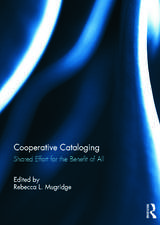Special Libraries: A Survival Guide
Autor James M. Matarazzo Ph.D., Toby Pearlsteinen Limba Engleză Paperback – 22 apr 2013 – vârsta până la 17 ani
Preț: 333.24 lei
Preț vechi: 452.27 lei
-26% Nou
Puncte Express: 500
Preț estimativ în valută:
63.79€ • 69.31$ • 53.61£
63.79€ • 69.31$ • 53.61£
Carte tipărită la comandă
Livrare economică 22 aprilie-06 mai
Preluare comenzi: 021 569.72.76
Specificații
ISBN-13: 9781610692670
ISBN-10: 1610692675
Pagini: 192
Dimensiuni: 178 x 254 x 18 mm
Greutate: 0.41 kg
Editura: Bloomsbury Publishing
Colecția Libraries Unlimited
Locul publicării:New York, United States
ISBN-10: 1610692675
Pagini: 192
Dimensiuni: 178 x 254 x 18 mm
Greutate: 0.41 kg
Editura: Bloomsbury Publishing
Colecția Libraries Unlimited
Locul publicării:New York, United States
Caracteristici
Presents case studies of corporate and other special library reductions and closures and provides strategies to minimize your chances of becoming a victim
Notă biografică
James M. Matarazzo, PhD, is dean and professor emeritus at the Graduate School of Library and Information Science at Simmons College, Boston, MA. Toby Pearlstein, PhD, is retired director of global information services for Bain & Company, Inc., a strategic management consulting firm.
Cuprins
ForewordSylvia JamesIntroductionBarbara QuintPART I YOU ARE WHAT YOU MEASURE: THE IMPORTANCE OF DATA AS A SURVIVAL TOOLIntroductionJames M. Matarazzo and Toby Pearlstein1 Corporate Score: Marrying Two Expert Tools Will Help You Sustain Your Corporate LibraryJames M. Matarazzo and Toby Pearlstein2 Case Study: The AT&T Bell Laboratories Library NetworkDonald T. Hawkins3 Preface: The Glass Is Half FullA Review of Research Related to the Management of Corporate LibrariesJames M. Matarazzo and Toby PearlsteinPART II STRATEGIES AND TACTICS FOR SURVIVALIntroductionJames M. Matarazzo and Toby Pearlstein4 Staying Afloat in Turbulent WatersJames M. Matarazzo and Toby PearlsteinWith Lynne Palombo, Leigh Montgomery, and Elaine RainesAfterword: News Libraries: An UpdateLeigh Montgomery5 Corporate Libraries: A Soft Analysis and a WarningJames M. Matarazzo and Toby PearlsteinCompanion Essay: A Warning from the UKSylvia James6 Alternate Sourcing: A Critical Component of Your Survival ToolkitJames M. Matarazzo and Toby Pearlstein7 Resuscitated: The EPA Libraries' Near-Death ExperienceJames M. Matarazzo and Toby PearlsteinAfterword Redux: EPA Libraries at 40-Looking Toward a Bright FutureDeborah Balsamo8 Educating Special Librarians: "The Past Is Prologue"James M. Matarazzo and Toby Pearlstein9 Educating Special Librarians: In Search of a ModelJames M. Matarazzo and Toby Pearlstein10 Scenario Planning as Preventive MedicineJames M. Matarazzo and Toby Pearlstein11 Professional Association Membership as a Survival ToolSylvia James12 Corporate Library Survival outside the United States: Lessons from New Zealand and AustraliaGillian Ralph and Julie SibthorpePART III SO WHAT DOES YOUR MANAGER THINK?IntroductionJames M. Matarazzo and Toby PearlsteinCompanion Essay: Investment Management, Buy-Side Research, and the Information ProfessionalSylvia James13 What the Library Has to Do to Be SuccessfulChuck Pickelhaupt14 Information Services at Bain & Co., Inc.: Adding Value to the Future of the FirmMichael Zimmerman Interviews Steven Tallman15 Putnam Investments Corporate LibraryPatrick O'DonnellIndex
Recenzii
The book constitutes a master class in planning for specialized information services. It is a must-read for special librarians concerned about their professional futures and is equally relevant for educators charged with developing competencies in library students. I highly recommend that library science educators include the book in their curricula, and I urge every special librarian to treat the book as a daily companion. We owe Matarazzo and Pearlstein a huge gratitude for having 'pulled it all together' for us
Readers will gain insight into closure avoidance strategies by digesting the content of this well-written, straightforward book. The writers do emphasize special libraries, but the strategies and models could easily be adapted to academic and public library situations. The book is highly recommended for special/corporate libraries and academic libraries that support schools of library and information science.
Readers will gain insight into closure avoidance strategies by digesting the content of this well-written, straightforward book. The writers do emphasize special libraries, but the strategies and models could easily be adapted to academic and public library situations. The book is highly recommended for special/corporate libraries and academic libraries that support schools of library and information science.










